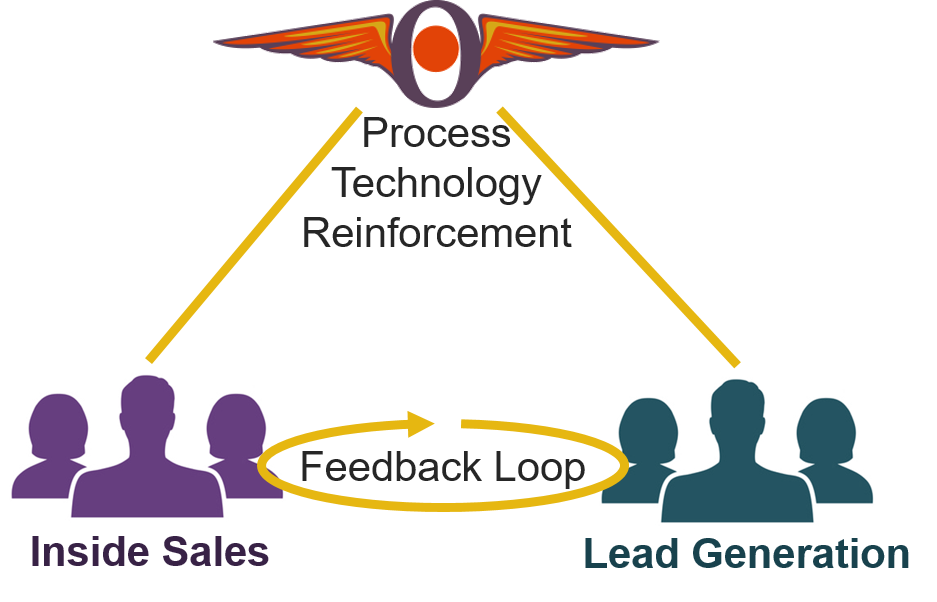Should Inside Sales Report to Marketing or Sales?
To look at this question, should inside sales report to marketing or sales, a bit more closely, let’s ask it differently. Is the ISR / SDR better aligned with marketing or with sales?
According to Bridge Group, in 2014 24% of SDRs reported to marketing and this number has been increasing among both large and small companies based on insights from AA-ISP 2016 Leadership Summit.
What is driving this change in reporting structure?
My observations say it’s two very different things.
First is a scenario where marketing isn’t in a position to supply all the leads needed to meet sales goals and they look to an outbound sales team to develop additional leads.
Second is the realization that a strong feedback loop improves buyer understanding and thus campaign effectiveness when the two are aligned.
Let’s look at each of these a moment.
Outbound Lead Generation
The 2014 CSO Insights Sales Performance Optimization study found that marketing departments provide only about 26% of qualified leads pursued by sellers and nearly half are self-generated by reps. When marketing realizes this, a logical action is to establish an outbound team as an extension of the marketing team. This allows them to work from the same playbook and coordinate efforts. The outbound team gains structure and content from marketing to help them develop and hone their outbound efforts. These marketing teams aren’t just handing stale purchased lists to a telesales team to blindly call. They agree on an Ideal Customer Profile (ICP) and the right value messaging. Marketing provides content that can be shared over multiple channels. And the outbound SDR team uses research skills to figure out where those targets “hang out” and develops them over time with a planned cadence of activities.
Feedback Loop
Next, the feedback loop. Aligned teams do more than just sit together. To be aligned, teams must collaborate. No more “throwing leads over the wall” like the old days.
“It’s not enough to say ‘collaboration is working together.’ Collaboration is about working together to achieve better results faster. To achieve this future state, collaboration requires a clear vision of success, shared goals, and principles based on a common language to enable people from different functions (not only marketing) to work together to achieve better results faster.” Source: 2015 CSO Insights
Today’s highly skilled SDR is the true bridge between functions, and owns skillsets that are found in both. They have the skills and the tools to develop a deep understanding of the individual buyers, accounts, and territories. In their 2014 book The Collaborative Sale, Eades and Sullivan call them The Micro-Marketer Persona because they are essentially a target marketing department of one. But that doesn’t mean they REPLACE marketing. And they not blasting out indiscriminately. It means that the old days of smile-and-dial are gone. Today’s BDR engages in a mix of activities, which might mean calls, email, online seminars, tradehows, and social media. With such frequent interaction and deep understanding of the buyer, they can give immediate feedback to marketing who can hone messaging and content immediately. I’ve seen teams who essentially pair up marketing reps and SDRs to collaborate and iterate daily.
Give all this, it sounds like a perfect scenario to embed inside sales into the marketing lead generation group. Here are a few points to take into account:
- Make sure SDRs get coaching. SDR performance improves dramatically with weekly coaching. A dedicated Sales Manager or Coach is best for this.
- Respect the calling hours. One of the biggest complaints I hear from ISRs or SDRs is having to sit through hours of marketing meetings during peak calling time.
- Rethink incentives. When you put sales and marketing on the same team, their goals need to be shared. If marketing is generating inbound leads especially, they need to be held accountable at some level for lead quality and closed revenue. Adjust bonuses for this.
- Defend their commissions. Sales needs to have a champion on their side to make sure all the commissions are right. This is new territory for marketing.
- Add Sales Enablement. Sales enablement brings together the essentials needed to drive maximum results.
To answer our question, should inside sales report to marketing or sales, the answer really is, “It depends”. However, the trend toward inside sales reporting to marketing is a step toward better sales and marketing alignment. There are considerations to be made, but if managed well, offers considerable benefit to the buyer and the bottom line.
- Up to the minute messaging and understanding of the buyer
- Better synergy for targeted, account based sales and marketing initiatives
- Immediate understanding and immersion in each campaign
- Better agreement on MQL and faster response time
- Additional volume of SQL leads to hit revenue targets
- Direct feedback loop that benefits both the marketer and sales rep in achieving their goals
Suggested reading: CSO Insights just came out with their 2016 survey and Tamara Schenk posted on Sales and Marketing Alignment

